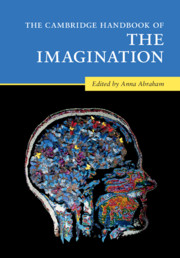Book contents
- The Cambridge Handbook of the Imagination
- The Cambridge Handbook of the Imagination
- Copyright page
- Dedication
- Contents
- Figures
- Contributors
- Acknowledgments
- 1 Surveying the Imagination Landscape
- Part I Theoretical Perspectives on the Imagination
- 2 The Evolution of a Human Imagination
- 3 Material Imagination: An Anthropological Perspective
- 4 The Archaeological Imagination
- 5 Philosophical Perspectives on Imagination in the Western Tradition
- 6 Imagination in Classical India: A Short Introduction
- 7 From Prediction to Imagination
- 8 Memory and Imagination: Perspectives on Constructive Episodic Simulation
- 9 Capturing the Imagination
- 10 A Sociocultural Perspective on Imagination
- 11 Artificial Intelligence and Imagination
- Part II Imagery-Based Forms of the Imagination
- Part III Intentionality-Based Forms of the Imagination
- Part IV Novel Combinatorial Forms of the Imagination
- Part V Phenomenology-Based Forms of the Imagination
- Part VI Altered States of the Imagination
- Name Index
- Subject Index
- References
8 - Memory and Imagination: Perspectives on Constructive Episodic Simulation
from Part I - Theoretical Perspectives on the Imagination
Published online by Cambridge University Press: 26 May 2020
- The Cambridge Handbook of the Imagination
- The Cambridge Handbook of the Imagination
- Copyright page
- Dedication
- Contents
- Figures
- Contributors
- Acknowledgments
- 1 Surveying the Imagination Landscape
- Part I Theoretical Perspectives on the Imagination
- 2 The Evolution of a Human Imagination
- 3 Material Imagination: An Anthropological Perspective
- 4 The Archaeological Imagination
- 5 Philosophical Perspectives on Imagination in the Western Tradition
- 6 Imagination in Classical India: A Short Introduction
- 7 From Prediction to Imagination
- 8 Memory and Imagination: Perspectives on Constructive Episodic Simulation
- 9 Capturing the Imagination
- 10 A Sociocultural Perspective on Imagination
- 11 Artificial Intelligence and Imagination
- Part II Imagery-Based Forms of the Imagination
- Part III Intentionality-Based Forms of the Imagination
- Part IV Novel Combinatorial Forms of the Imagination
- Part V Phenomenology-Based Forms of the Imagination
- Part VI Altered States of the Imagination
- Name Index
- Subject Index
- References
Summary
Research concerning the relation between memory and imagination has focused increasingly on how memory contributes to imagining or simulating future and other hypothetical events. According to the constructive episodic simulation hypothesis (Schacter and Addis, 2007a, 2007b), episodic memory plays an important role in supporting the construction of imagined future events by allowing the retrieval and flexible recombination of elements of past experiences into simulations of possible future scenarios. Further, the hypothesis holds that the same flexible recombination processes that are useful for simulating possible future experiences can produce memory errors that result from miscombining elements of past experiences. A growing number of experimental studies during the past decade have examined various aspects of this hypothesis. Here, we consider (1) cognitive studies that have tested key elements of the constructive episodic simulation hypothesis; (2) neuroimaging studies that have elucidated the neural underpinnings of the constructive episodic simulation hypothesis; (3) recent experimental evidence linking flexible recombination and episodic simulation processes with memory errors; and (4) ways in which the conceptual focus of constructive episodic simulation hypothesis has changed over the past decade.
Information
- Type
- Chapter
- Information
- The Cambridge Handbook of the Imagination , pp. 111 - 131Publisher: Cambridge University PressPrint publication year: 2020
References
Accessibility standard: Unknown
Why this information is here
This section outlines the accessibility features of this content - including support for screen readers, full keyboard navigation and high-contrast display options. This may not be relevant for you.Accessibility Information
- 45
- Cited by
